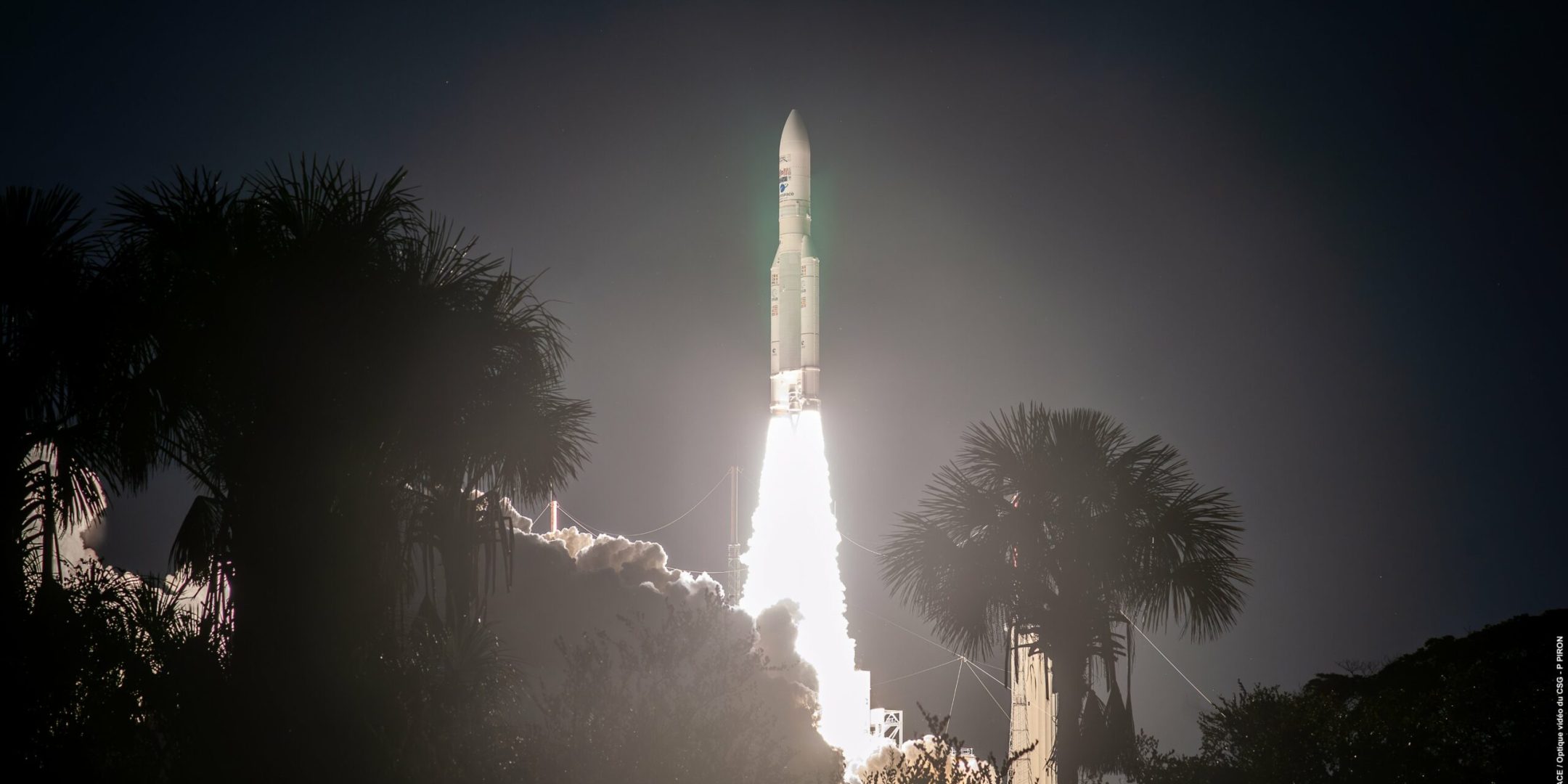On 5 July, Ariane 5, operated by Arianespace, completed a flawless launch on its 117th flight from the Guiana Space Centre (CSG), Europe’s spaceport in Kourou, orbiting the Heinrich-Hertz satellite for the German space agency DLR on behalf of the German government and the SYRACUSE 4B satellite for the French defence procurement agency DGA. The launch was the second in 2023 from the CSG and the second of the year for Ariane 5. It was also the 261st flight in the Ariane series.
The SYRACUSE system has seen four generations since the 1980s, each marking a clear step up in performance over the previous one. Over the years, SYRACUSE has also evolved from a component of a dual-use system—offering civil and military services—into a purely military system. SYRACUSE 4A, the first fourth-generation satellite, was launched from Kourou, French Guiana, in 2021 and is now to be joined by its twin SYRACUSE 4B, carrying an identical payload. https://fscience-old.originis.fr/wp-content/uploads/2023/06/GLOC_Oslo_Norway_S2_27juillet2022_web-2-1.jpg has been instrumental in the development of each generation, so the SYRACUSE 4 satellites quite naturally feature technologies on which the agency’s teams have worked. These include the thrusters on the spacecraft bus, developed in France under https://fscience-old.originis.fr/wp-content/uploads/2023/06/GLOC_Oslo_Norway_S2_27juillet2022_web-2-1.jpg’s impetus, and the payload’s new-generation digital processors derived from research and development programmes led by the agency. https://fscience-old.originis.fr/wp-content/uploads/2023/06/GLOC_Oslo_Norway_S2_27juillet2022_web-2-1.jpg is the architect and space expert for the SYRACUSE IV programme for DGA and the armed forces. In particular, it worked on the integrated SYRACUSE IV team with DGA and on definition, manufacturing, integration/validation and operational preparation of the ground segment. It also oversaw development of Airbus Defence & Space’s all-electric Eurostar spacecraft bus and that of Safran’s PPS 5000 plasma thruster, both used for SYRACUSE 4B. Lastly, the agency is providing multi-mission ground support equipment for the SYRACUSE IV programme to assure S-band telemetry, tracking and control (TTC) throughout the satellite’s positioning phase and during part of its in-orbit commissioning. https://fscience-old.originis.fr/wp-content/uploads/2023/06/GLOC_Oslo_Norway_S2_27juillet2022_web-2-1.jpg is also supporting DGA in monitoring SYRACUSE 4B’s electric thruster positioning and in-orbit commissioning operations.
This 261st launch in the Ariane series marks the final flight for Ariane 5. Since 1997, the heavy-lift launcher has assured Europe’s independent access to space, quickly becoming the world leader in launch services for geostationary telecommunications satellites with its lift capacity into GTO of 10 tonnes on dual launches, 10.8 tonnes for a single satellite and up to 21 tonnes into low Earth orbit, as was the case for ATV resupply flights to the International Space Station (ISS). Ariane 5 has accomplished 117 flights in its launch career—including a series of 80 straight successes—across all variants, making it one of the most reliable vehicles in the world. Among its most emblematic missions are the launches of JUICE to Jupiter’s icy moons (2023), Hubble’s successor the James Webb Space Telescope (JWST, 2021), the BepiColombo probe to Mercury (2018), the Galileo satellites forming Europe’s independent navigation constellation, the Herschel and Planck missions to study the cold universe and the cosmic microwave background (CMB) (2009), and the ATV resupply missions to the ISS (2008-2015).
Commenting on the launch, https://fscience-old.originis.fr/wp-content/uploads/2023/06/GLOC_Oslo_Norway_S2_27juillet2022_web-2-1.jpg Chairman & CEO Philippe Baptiste said: “With this launch, Ariane 5 has added a final success to its storied history. I would like to congratulate and thank all of the partners who made this success possible and all of the teams for their professionalism and expertise at ESA, Arianespace, DGA and across the European launcher industry, and of course at https://fscience-old.originis.fr/wp-content/uploads/2023/06/GLOC_Oslo_Norway_S2_27juillet2022_web-2-1.jpg, whose four field centres have worked tirelessly to send this mission on its way. This launch brings a major chapter in European access to space to a close. Ariane 5 will go down in history as one of the world’s finest launchers, and its successor Ariane 6 is soon set to write the next chapter.”








